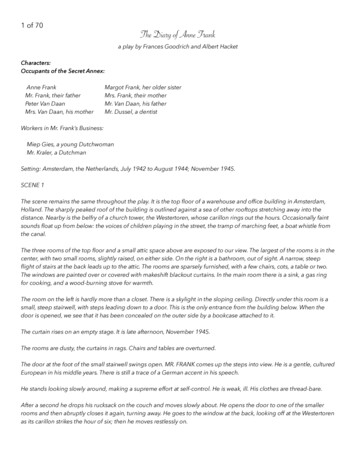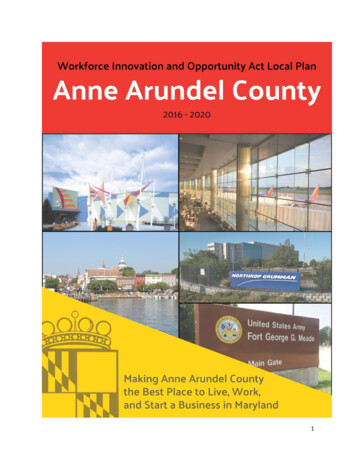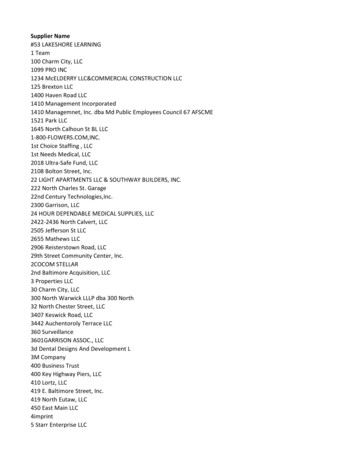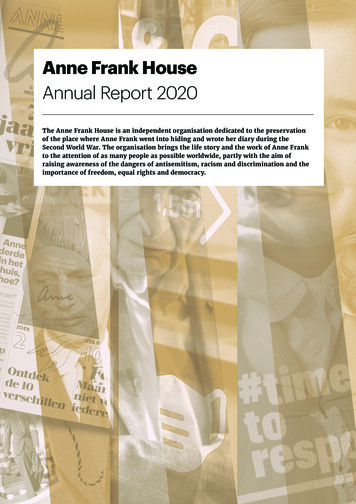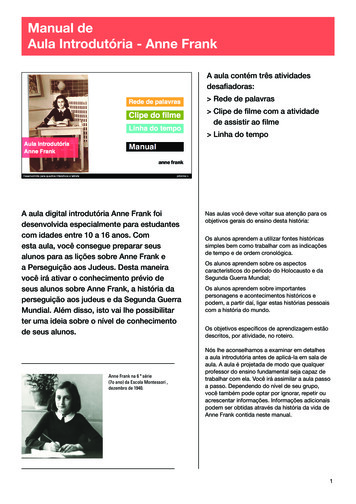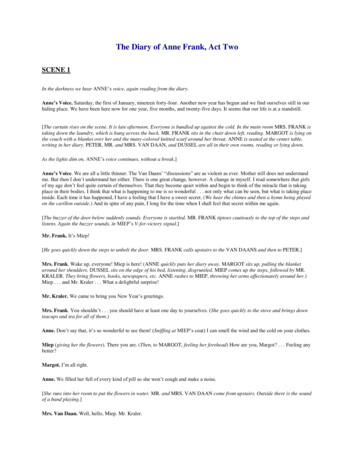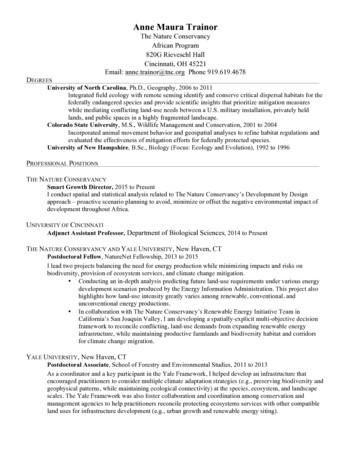
Transcription
Anne Maura TrainorThe Nature ConservancyAfrican Program820G Rieveschl HallCincinnati, OH 45221Email: anne.trainor@tnc.org Phone 919.619.4678DEGREESUniversity of North Carolina, Ph.D., Geography, 2006 to 2011Integrated field ecology with remote sensing identify and conserve critical dispersal habitats for thefederally endangered species and provide scientific insights that prioritize mitigation measureswhile mediating conflicting land-use needs between a U.S. military installation, privately heldlands, and public spaces in a highly fragmented landscape.Colorado State University, M.S., Wildlife Management and Conservation, 2001 to 2004Incorporated animal movement behavior and geospatial analyses to refine habitat regulations andevaluated the effectiveness of mitigation efforts for federally protected species.University of New Hampshire, B.Sc., Biology (Focus: Ecology and Evolution), 1992 to 1996PROFESSIONAL POSITIONSTHE NATURE CONSERVANCYSmart Growth Director, 2015 to PresentI conduct spatial and statistical analysis related to The Nature Conservancy’s Development by Designapproach – proactive scenario planning to avoid, minimize or offset the negative environmental impact ofdevelopment throughout Africa.UNIVERSITY OF CINCINNATIAdjunct Assistant Professor, Department of Biological Sciences, 2014 to PresentTHE NATURE CONSERVANCY AND YALE UNIVERSITY, New Haven, CTPostdoctoral Fellow, NatureNet Fellowship, 2013 to 2015I lead two projects balancing the need for energy production while minimizing impacts and risks onbiodiversity, provision of ecosystem services, and climate change mitigation. Conducting an in-depth analysis predicting future land-use requirements under various energydevelopment scenarios produced by the Energy Information Administration. This project alsohighlights how land-use intensity greatly varies among renewable, conventional, andunconventional energy productions. In collaboration with The Nature Conservancy’s Renewable Energy Initiative Team inCalifornia’s San Joaquin Valley, I am developing a spatially-explicit multi-objective decisionframework to reconcile conflicting, land-use demands from expanding renewable energyinfrastructure, while maintaining productive farmlands and biodiversity habitat and corridorsfor climate change migration.YALE UNIVERSITY, New Haven, CTPostdoctoral Associate, School of Forestry and Environmental Studies, 2011 to 2013As a coordinator and a key participant in the Yale Framework, I helped develop an infrastructure thatencouraged practitioners to consider multiple climate adaptation strategies (e.g., preserving biodiversity andgeophysical patterns, while maintaining ecological connectivity) at the species, ecosystem, and landscapescales. The Yale Framework was also foster collaboration and coordination among conservation andmanagement agencies to help practitioners reconcile protecting ecosystems services with other compatibleland uses for infrastructure development (e.g., urban growth and renewable energy siting).
Anne Maura TrainorAdditional responsibilities and professional accomplishments in this position include: Conducted outreach to private landowners, public land managers, and other groups throughoutthe United States to assist conservation planners and policy makers struggling to implementclimate adaptation strategies into spatially-explicit and climate-resilient landscape developmentplans and projects. Serve as a technical authority in analysis and interpretation of ecological scientific data relatedto climate change and ecosystem management. Communicated ecological research results in oral and written format via conferences and peerreviewed publications.COLORADO PARKS AND WILDLIFE, Fort Collins, COResearch Technician, Lynx Reintroduction Project. 2005 to 2006As the lead spatial ecologist and data manager, my primary responsibilities were to development andmanage long-term demographic and geospatial data sets. I also crafted environmental analysis for reportsand peer-reviewed publications.Additional responsibilities and professional accomplishments in this position include: Geospatial analysis of telemetry and vegetation data with geographic information systemsoftware (ArcGIS). Developed, organized, maintained the long-term dataset in geographic information system(GIS) format to improve research protocols Project manager and supervisor. Communicated ecological research results in oral and written format via conferences, reports,and peer-reviewed publications. Provide direction and technical support with database management and geospatial analysis tofellow scientist.MPALA RESEARCH CENTRE, Nanyuki, KenyaField Supervisor, Investigating biodiversity cascades in an east Africa Savanna. 2004 to 2005Ecologist supervising a long-term research project investigating biodiversity cascades in savannaecosystem.Additional responsibilities and professional accomplishments in this position include: Supervised and prioritized activities for crews and volunteers. Developed a database (Access) to facilitate analysis for reports and peer-review publications. Maintain and manage project equipment (including 4WD vehicles). Performed wildlife inventory and monitoring. Experience includes:o Small mammal trapping using Sherman live traps and ear tagging to record speciesrichness and abundance of small mammals in grasslands.o Reptile surveys to determine species presence or absence of snake species in savannahabitats.o Insect surveys in collaboration with disease ecologist to investigate how sandflies(Phlebotomus spp.), known vectors of leishmaniasis, are dependent upon rodentpopulations in termite mounds. Furthermore, I conducted tick abundance surveys toevaluate the effects of tick abundance is associated with rodent density.COLORADO PARKS AND WILDLIFE, Fort Collins, COField Supervisor, Preble’s Meadow Jumping Mouse. 1999 to 2001As supervisor, I successfully lead teams of researchers conducting mark-recapture trapping and radiotracking the nocturnal movements of the federally threatened Preble’s meadow jumping mouse, Zapushudsonius preblei. I was also lead spatial analyst and data manager for the project. This position allowed meto developed methods for systematically and transparently assessing how species movement behavior isassociated with U.S. Fish and Wildlife Service’s critical habitat definition.
Anne Maura TrainorAdditional responsibilities and professional accomplishments in this position include: Developed, designed and maintained long-term geospatial datasets (movement behavior viaradio-telemetry and vegetation data) to evaluate federally protected species movement capacityand critical habitat requirements in Microsoft Excel and Access. Produced annual summary reports of field-collected data for internal use and for compliancewith state and federal wildlife monitoring protocol. Hired, supervised, and prioritized activities for seasonal wildlife technicians. Trained field crew in mark-recapture (e.g., identifying, handling, and inserted PassiveIntegrated Transponder (PIT) tags) and radio-tracking techniques (anesthetizing, attachingradio-collar, GPS data collection, and radio telemetry protocol). Wrote peer-reviewed publication and communicated ecological research results in oralpresentations.CHARLES DARWIN RESEARCH STATION, Galapagos Islands, EcuadorField Supervisor, Department of Protection, Ornithology. 1998 to 1999Supervised fieldwork evaluating the reproductive biology and breeding success of the endangeredMangrove Finch.Responsibilities: Lead a team of researchers (logistics, planning, and organized equipment for field excursionsfield research trip). Investigated various techniques estimating population size (point counts and line transects). Performed data collection, management, and analysis. Communicated ecological research results in publication for the National Park Service of theGalapagos and Charles Darwin Research Station.Research Assistant, Department of Protection, 1998 to 1998Collaborated with 6 researchers with information management, technical support, and data collection in thefield. Completed challenging assignments requiring teamwork while enhancing strong interpersonal skillsworking closely with small groups in adverse conditions.Responsibilities: Established protocol and operated a species-monitoring program with GPS equipment forfuture use in GIS software. Performed GPS data management for the department and inter-organizational GIS project. Implemented a protocol for data collected with Garmin GPS units in the field. Independently learned new software and computer technology enhancing my ability to identifyand solve data management problems. Surveyed reptile, mammal (rodent and ungulate), and bird populations.UNIVERSITY OF NEW HAMPSHIRE, Durham, NHSKILLSResearch Assistant, Dept. of Botany. 1995 to 1995. Investigated tree distribution in relationship to global warming trends. Performed data collection, entry, and management via Microsoft Excel.Research Assistant, Dept. of Zoology, Lakes Lay Monitoring Program. 1994 to 1994. Digitized scales of fresh water fish to determine age and growth rate.Software: ArcGIS, Microsoft Access, Circuitscape, Maxent, ERDAS Imagine and ENVI (processing satelliteimagery), Fusion (Processing LiDAR data), MARK, Distance, Adobe IllustratorProgramming: R, SAS, Python, Visual BasicModeling concepts: Multi-objective optimization, Graph theory, Multivariate ordination, Cluster analysis, Discretechoice modeling, Information-theoretic inference, Linear regression models with mix effects, Resource selectionmodels, Species distribution models for current and future climates, Spatial analysis and autocorrelation, Homerange estimation, Demographic parameters estimation
Anne Maura TrainorTEACHING EXPERIENCECo-Instructor, Conservation Science, 2014. [FES 744]School of Forestry and Environmental Studies, Yale University, New Haven, CTResponsibilities: Developed curriculum and lab exercises with a real world context, selectedclearly written primary literature to enhance scientific literacy for a diverse array of students (e.g.,backgrounds in ecology, forestry, sociology and policy), and guided students in designing,implementing, analyzing, and present results from a semester-long project.Teaching Assistant, Introduction to Geographic Information Systems. 2011. [GEOG 491]Geography Department, University of North Carolina, Chapel Hill, NC.Responsibilities: Lead instructor for lab section, created innovative presentations to help studentsbecome proficient with complex computer software.Teaching Assistant, Introduction to Distance Sampling Workshop. 2006.Fish, Wildlife, and Conservation Biology Department, Colorado State University, Fort Collins, CO.Responsibilities: Organized teaching and lab material while assisting students with implementingstatistical software and data interpretation.Teaching Assistant, Ecology of African Savannas (Kenyan Field Portion). 2004.Biology Department, Bard College, Annandale-on-Hudson, NY.Responsibilities: Through hands-on learning, I taught undergraduate students how to examinescientific issues related to biological diversity in a novel ecosystem. I also mentored studentsimplementing month-long field research projects.Teaching Assistant. Wildlife Data Collection and Analysis. 2002. [FW 471]Fish, Wildlife, and Conservation Biology Department, Colorado State University, Fort Collins, CO.Responsibilities: I taught undergraduates field methods and statistical analysis. I also developedseveral lectors and lab exercises in my area of expertise (e.g., animal movement behavior).RESEARCH GRANTSS. Baruch-Mordo, A. M. Trainor, J. Kiesecker, J. Fargione, and J. RyanImpacts of hydraulic fracturing on water quantity and quality for nature and people: Are we prepared for thefuture? National Center for Ecological Analysis and Synthesis (NCEAS) and Science for Nature and People(SNAP). 260,000As a co-lead and a key participant in the working group, I am collaborating with hydrologists,environmental engineers, policy experts, government agencies and industry to proactively highlightpotential impacts and risks of water use and waste water contamination from hydraulic fracturing on bothnature and people.PUBLICATIONSTrainor A. M., McDonald, R.I., and Fargione, J., Energy Sprawl in the United States: The Land Use Effects ofRenewable and Unconventional Energy Sources. BioScience In ReviewMcLean, K. A., A. M. Trainor, G. Asner, P. Jansen, M. Crofoot, M. Hopkins, C. Campbell, R. Martin, D. Knapp.Movement patterns of three arboreal primates in a Neotropical moist forest explained by LiDAR-estimatedcanopy structure. Journal of Animal Ecology In ReviewTrainor A. M., C. M. Donihue, K. A. McLean, O. J. Schmitz. 2014 Projecting the likelihood of communitydisassembly under climate change: A geospatial food web module approach. PlosOne In ReviewWiederholt, R., A. M. Trainor, N. Michel, P. Shirey, R. Swaisgood, D. Tallamy, Cook Patton S. C. 2015. The faceof conservation responding to a dynamic changing world. Integrative Zoology.DOI: 10.1111/1749-4877.12151Schmitz, O. J., J. J. Lawler, P. Beier, C. Groves, G. Knight, D. Boyce, J. Bulluck, K. M. Johnston, M. L. Klein, K.Muller, J. Pierce, J. Strittholt, D. M. Theobald, S. Trombulak, A. M. Trainor, W. Singleton. 2015.Conserving Biodiversity in an Era of Climate Change: Some Practical Guidance about AdaptationApproaches in Support of Land-use Planning. Natural Areas Journal. 35:190-203
Anne Maura TrainorPUBLICATIONS (cont.)Trainor A. M. and O. J. Schmitz. 2014. Infusing food web ecology into analyses of geographic distributions ofSpecies. Ecology Letters. 17: 1507-1517Breckheimer, I., N. M. Haddad, W. F. Morris, A. M. Trainor, B. Hudgens, W. Fields, R. T. Jobe, A. Moody, and J.R. Walters. 2014. Defining and evaluating the umbrella species concept for conserving and restoringlandscape connectivity. Conservation Biology. 28: 1584-1593Schmitz, O. J., and A. M. Trainor. Adaptation approaches for conserving ecosystems services and biodiversity indynamic landscapes caused by climate change. V. Sample and R. P Bixler (eds). Forest Conservation andManagement in the Anthropocene: Conference Proceedings. RMRS-P-71. Fort Collins, CO US Departmentof Agriculture, Forest Service, Rocky Mountain Research Station. Pg 297-309Trainor A. M., O. J. Schmitz, J. Ivan, and T. M. Shenk. 2014. Enhancing species distribution modeling bycharacterizing predator-prey interactions. Ecological Applications. 24: 204-216Trainor A. M., J. R. Walters, W. F. Morris, J. Sexton, and A. Moody. 2013. Empirical estimation ofdispersal resistance surfaces: A case study with Red-cockaded Woodpeckers. Landscape Ecology.28:755767Trainor A. M., J. R. Walters, D. L. Urban and A. Moody. 2013 Evaluating the effectiveness of a Safe HarborProgram for connecting wildlife populations. Animal Conservation.16: 610-620Trainor A. M., T. M. Shenk, and K. R. Wilson 2012. Spatial, temporal, and biological factors associated withPreble’s meadow jumping mouse (Zapus hudsonius preblei) home range. Journal of Mammalogy. 93:429438Trainor A. M., T. M. Shenk, and K. R. Wilson. 2007. Microhabitat characteristics of Preble’s meadow jumpingmouse high-use areas. Journal of Wildlife Management. 71:469-477Trainor A. M., K. R. Wilson, and T. M. Shenk. 2007. Response of Preble’s meadow jumping mouse(Zapus hudsonius preblei) to resource supplementation. American Midland Naturalist. 158:338-353PUBLICATIONS IN PREPARATIONSmith, J. R.* and Trainor, A. M. Modeling the distribution of invasive plant species: Moving beyond thebioclimatic envelope. Target Journal: Nature Climate ChangeTrainor A. M., J. R. Walters, and A. Moody. Environmental and conspecific cues influencing prospectingbehavior. Target Journal: Animal BehaviourSELECTED PRESENTATIONSTrainor A. M. 2015. Hydraulic Fracturing and Water: Are We Prepared for Future Impacts? The NatureConservancy Board of Trustee’s Meeting, Austin, TX. InvitedTrainor A. M. 2015. “Finding common ground: Integrating spatial ecology and conservation science intoland-use planning”. Department of Biological Sciences, University of Cincinnati, Cincinnati, OH. InvitedTrainor A. M. 2015. “Finding common ground: Integrating spatial ecology and conservation science intoland-use planning”. Department of Biological Sciences, Ohio University, Athens, OH. InvitedTrainor A. M. and O. J. Schmitz. 2014. “Infusing community ecology into species geospatial distributions: ATrophic module approach. Gordon Research Conference on Predator-Prey Interactions”. Ventura, CATrainor, A. M. 2011. “A Framework for Integrating Climate Adaptation and Landscape Conservation Planning.Ecological Society of America. Emerging Issues Conference”. Shepherdstown, WVTrainor A. M., J. R. Walters, and A. Moody. 2011. “Evaluation of Safe Harbor Program influence on current andfuture connectivity: Case study of the Red-cockaded Woodpecker” United States Regional Association ofthe International Association for Landscape Ecology (US-IALE). Newport, RITrainor A. M., K. R. Wilson, and T. M. Shenk. 2007. “Spatial Response of Preble’s Meadow Jumping Mouse(Zapus hudsonius preblei) to Resource Supplementation” Association of American Geographers. SanFrancisco, CATrainor A. M. K. R. Wilson, and T. M. Shenk. 2006. “Changes in the spatial distribution of Preble’smeadow jumping mouse after resource supplementation.” Eastern Oregon Agricultural Research Center,Oregon State University, Union, OR. InvitedTrainor A. M., K. R. Wilson, and T. M. Shenk. 2004. “Influence of resource addition on the distribution ofPreble’s meadow jumping mouse.” The Wildlife Society. Burlington, VT.
Anne Maura TrainorHONORS AND AWARDS Ecological Society of America Travel Award 2012. 1000. Ecological Society of AmericaGraduate Education Advancement Board Impact Award. 2010. 500. University of North CarolinaGraduate SchoolUSDA-NIFA Professional Enhancement Award. 2010. 500. International Association for LandscapeEcologyInterdisciplinary Research Fellowship. Spring 2009. University of North Carolina Graduate SchoolGIS, Remote Sensing, and Telemetry Working Group 2008. Travel Grant. 500. The Wildlife SocietyAAG Biogeography Best Poster Award 2008. 100. Association of American GeographersAAG International Geographic Information Fund 2007. Student Travel Award. 500. Association ofAmerican GeographersCum Laude and Dean’s List. University of New HampshirePROFESSIONAL AFFILIATIONS Society for Conservation BiologyEcological Society of AmericaUnited States Regional Association of the International Association for Landscape Ecology (US-IALE)American Society of MammalogistsThe Wildlife SocietyPROFESSIONAL SERVICES AND ACTIVITIESReviewer: PNAS, PLOSOne, Journal of Biogeography, Biological Conservation, Landscape Ecology,Canadian Journal of Zoology, The Southwestern Naturalist, and Journal of Applied Ecology,Ecological ModellingGuest editor: The Southeastern NaturalistSymposia ConvenerSchmitz, O.J., A.M. Trainor, and P. Beier. 2012. Towards Conservation Assessments for ClimateAdaptation: Presentation and Evaluation of a Framework. North America Congress forConservation Biology. Oakland, CACostanza, J., A. M. Trainor, and M. Simon. 2009. The Social Context of Landscape Conservation:Communication and Collaboration with Citizen Stakeholders. United States RegionalAssociation of the International Association for Landscape Ecology. Snowbird, UTWomen in Science at Yale MentorBoard Member: Triangle Chapter of the Society for Conservation Biology 2008-2009Treasurer: Department of Geography Graduate Student Association 2007-2008Department of Geography Senator for UNC Graduate and Professional Student Federation 2006 – 2007
Anne Maura Trainor TEACHING EXPERIENCE Co-Instructor, Conservation Science, 2014.[FES 744] School of Forestry and Environmental Studies, Yale University, New Haven, CT Responsibilities: Developed curriculum and lab exercises with a real world context, selected clearly written primary literature to enhance scientific literacy for a diverse array of students (e.g.,
